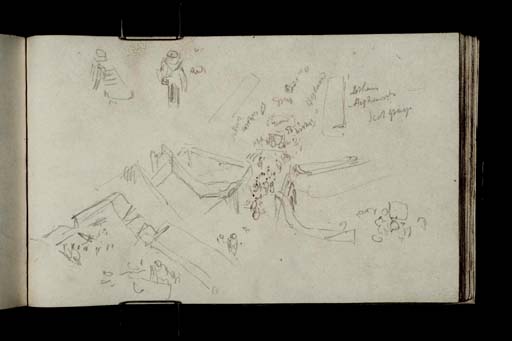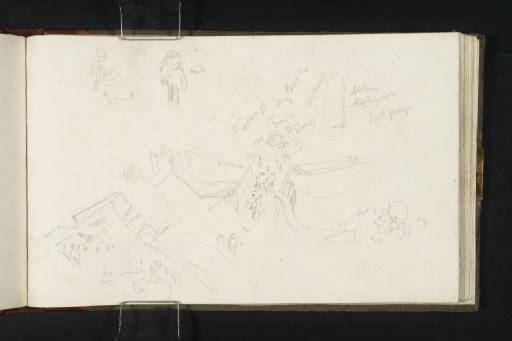Joseph Mallord William Turner The Procession to Edinburgh Castle with the Regalia seen from the Castle: The King's Carriage at the Barrier Gate 1822
Image 1 of 2
-
 Joseph Mallord William Turner, The Procession to Edinburgh Castle with the Regalia seen from the Castle: The King's Carriage at the Barrier Gate 1822
Joseph Mallord William Turner, The Procession to Edinburgh Castle with the Regalia seen from the Castle: The King's Carriage at the Barrier Gate 1822 -
 Joseph Mallord William Turner, The Procession to Edinburgh Castle with the Regalia seen from the Castle: The King's Carriage at the Barrier Gate 1822 (Enhanced image)Enhanced image
Joseph Mallord William Turner, The Procession to Edinburgh Castle with the Regalia seen from the Castle: The King's Carriage at the Barrier Gate 1822 (Enhanced image)Enhanced image
Joseph Mallord William Turner,
The Procession to Edinburgh Castle with the Regalia seen from the Castle: The King's Carriage at the Barrier Gate
1822
Joseph Mallord William Turner 1775–1851
Folio 36 Verso:
The Procession to Edinburgh Castle with the Regalia seen from the Castle: The King’s Carriage at the Barrier Gate 1822
D17565
Turner Bequest CC 36a
Turner Bequest CC 36a
Pencil on white wove paper, 114 x 187 mm
Inscribed in pencil by Turner ‘Red’ centre top to the right of the figures; around the Esplanade ?‘company of | archers’, ‘Grey’, ‘Highlanders’, ‘Yeomen’, ‘[...]’, to the right of the Esplanade ‘Lothian | Highlanders | Scot grays’
Blindstamped with the Turner Bequest stamp bottom right
Inscribed in pencil by Turner ‘Red’ centre top to the right of the figures; around the Esplanade ?‘company of | archers’, ‘Grey’, ‘Highlanders’, ‘Yeomen’, ‘[...]’, to the right of the Esplanade ‘Lothian | Highlanders | Scot grays’
Blindstamped with the Turner Bequest stamp bottom right
Accepted by the nation as part of the Turner Bequest 1856
References
1909
A.J. Finberg, A Complete Inventory of the Drawings of the Turner Bequest, London 1909, vol.I, p.611, CC 36a, as ‘Procession, or ceremony, seen from above. On right – “Lothian Highlanders,” and “Scots Grays.”.
1975
Gerald Finley, ‘J.M.W. Turner’s Proposal for a “Royal Progress”’, The Burlington Magazine, vol.117, January 1975, pp.32 note 28, 33–4 figure 28.
1981
Gerald Finley, Turner and George the Fourth in Edinburgh 1822, exhibition catalogue, Tate Gallery, London 1981, pp.20, 27, 83, [134] reproduced as ‘The King’s procession to the castle. Sketching from the parapet of the King’s Lodgings, Turner depicts the moment when the King alights from his carriage onto a crimson cloth at the barrier gate, where the Lord High Constable and Lord Cathcart were stationed to receive him; “Lothian Highlanders”, “Scots Grays”, “Yeomen”’.
One of the most important and spectacular events of the royal visit to Scotland took place on 22 August 1822: the procession to the castle with the Regalia of Scotland. The processing of the crown, sceptre and sword by their three respective bearers was the third ceremony with the Regalia devised by Sir Walter Scott.1 The first ceremony in which the Regalia were removed from the castle, took place on 12 August, before the King’s arrival, and Turner may have sketched the second event on folio 36 (Tate D17563).
The carriage is shown again on the present page, which depicts the arrival of the king at the gates to the castle, and is the first of a series of sketches made from the Half Moon Battery and the parapet of the King’s Lodgings of Edinburgh Castle connected to the procession. It is drawn with the sketchbook inverted. Other sketches show the assembled spectators and troops (folios 38 verso, 54 verso–55, 56, 56 verso–57 and 57 verso; D17569, D17600–D17601, D17603 and D17604–D17605, D17606). Further sketches from this spot show parts of the castle in connection to this event (folios 41 verso–42 and 43, 42 verso and 55 verso; Tate D17575–D17576 and D17578, D17577, D17602). Finally Turner took advantage of the unique vantage point at the top of Edinburgh Castle to make several views of the city (folios 59 verso–60 and 60 verso–61; Tate D17610–D17611, D17612–D17613).
The present sketch, drawn with the book inverted, was made from what Gerald Finley refers to as the ‘King’s Lodgings’, an east-facing apartment in the royal palace of Edinburgh Castle, and looks down over the Half Moon Battery at the bottom left of the page to the Castle Gate and Esplanade beyond. Finley identified this sketch as showing ‘the moment when the King alights from his carriage with a crimson cloth at the barrier gate, where the Lord High Constable and Lord Cathcart were stationed to receive him.’ Indeed the coach, also depicted on folio 35 verso (D17563), can be seen in the centre of the picture drawn up alongside the gate. In front of the coach is a square which must be the red carpeted platform on which the king alighted flanked by guards. The gate is not the grand gatehouse of today (erected in 1886–8) but a simpler functional structure visible in James Skene’s watercolour, King George IV at Edinburgh Castle, circa 1822 (Edinburgh City Libraries), before the stone archway.
There are guards in the inner barrier and on the Half Moon Battery, and behind the coach are two stands with inscriptions indicating the rows of assembled troops: The Royal ‘company of archers’, Scots ‘Greys’, ‘Highlanders’, ‘Yeomen’, ‘Lothians’ (probably East Lothian as in folio 38 verso; D17569), and more ‘Highlanders’ (perhaps of a different clan), and ‘Scot[s] grays’.2 Two of the Yeomen, one dressed in ‘red’, are drawn at the top right of the drawing to record their costumes as in folio 35 verso. The shapes at the bottom left of the page are probably a separate study of figures and perhaps the King’s coach.
Thomas Ardill
September 2008
The bearers of the Regalia were Alexander Douglas Duke of Hamilton, Frances Levenson-Gower Duke of Sutherland representing the Countess of Sutherland, and the Earl of Erroll.
How to cite
Thomas Ardill, ‘The Procession to Edinburgh Castle with the Regalia seen from the Castle: The King’s Carriage at the Barrier Gate 1822 by Joseph Mallord William Turner’, catalogue entry, September 2008, in David Blayney Brown (ed.), J.M.W. Turner: Sketchbooks, Drawings and Watercolours, Tate Research Publication, December 2012, https://www

